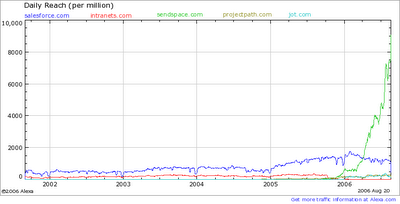Nothing like a little alphabet soup to start the day...
Croquet, a research platform that has escaped from the lab, sprung free by a startup called
Qwaq, proposes to be "an operating system for the post-browser Internet". Nothing ambitious, mind you.

The focus of their post-browser net vision is not publishing, but collaboration, purportedly on a large scale. Intriguingly, its architecture is peer-to-peer, so end-users can build the Croquet web one node at a time. That is a Good Idea. Today's server-centric net tends to serve organizations well, and individuals rarely. MySpace and Blogspot are about the extent of the user-defined net, and they don't support much more than blather.
The Croquet user experience is a 3D universe of interlinked worlds; or perhaps interlinked apartments, as each world is more likely to be a set of rooms than landscapes. Clearly the stack of overlapping "windows" pioneered by PARC and first commercialized by Apple is a terrible way to organize or present information. The browser, with its hyperlinks and history deck, is far more sensible, and akin to the ubiquitous spiral-bound notebook. Croquet takes this idea into the third dimension.
But 3D conveys the feel of wandering around with a patch over one eye and a cheap scuba mask on your face; you can't experience realistic 3D without stereoscopic display and peripheral vision. I've not seen any research showing that 3D UI dramatically improves on 2D UI for ordinary tasks. 3D is hugely popular for gaming, so the technology works, but it hasn't migrated to more productive uses. What does 3D add to mostly-textual content? Think about a bookshelf: it's a 2D array of titles; grab one, open it, and you see a pair of 2D pages, in a stack.
Another potential stumbling block for Croquet is its apparent complexity. Perhaps this is simply due to the way the web site describes it, but it sounds like a bear to master as a programmer. You have to learn smalltalk, for starters, and then a mountain of APIs and paradigms. The wonderful thing about the web is how little you need to know to do useful things. Given time, the Croquet team may hide some of its complexity. But given its academic origins, that time could be a long one.
Robert Scoble got
a demo recently. The
Wikipedia article describes the grand vision and project history.
Personally, I'd like to see a 2D, P2P, Read/Write web for personal and small-team applications; based on SVG, and incorporating PC documents/apps. Hmm, that sounds familiar... Oh right, I'm writing it! It's called airWRX.

 However, there is a fundamental difference between email and all the mechanisms that have been proposed to obsolete it: Email is peer-to-peer. Everything else is server-centered. Email uses servers, true, but they merely provide relay service or secondary storage. The email application sees a field of peers, identified by unique addresses, and reachable via the nearest SMTP service.
However, there is a fundamental difference between email and all the mechanisms that have been proposed to obsolete it: Email is peer-to-peer. Everything else is server-centered. Email uses servers, true, but they merely provide relay service or secondary storage. The email application sees a field of peers, identified by unique addresses, and reachable via the nearest SMTP service.
 As you might expect, most or all of these outfits offer hosted or intranet solutions. As such, they have to run the gantlet of the corporate IT dept for vetting/approval before they can solve any user problems. In other words, they can't spread virally among most enterprise users, a problem which consumer web services don't have.
As you might expect, most or all of these outfits offer hosted or intranet solutions. As such, they have to run the gantlet of the corporate IT dept for vetting/approval before they can solve any user problems. In other words, they can't spread virally among most enterprise users, a problem which consumer web services don't have. Oh. My. God.
Oh. My. God. I've written at some length on this blog about why that model hasn't caught on (and won't), and about an alternative model, the "always-on-you web", that brings web benefits to personal and team software without forcing your apps and data online. Have a look at the "Key Posts" sidebar group on my
I've written at some length on this blog about why that model hasn't caught on (and won't), and about an alternative model, the "always-on-you web", that brings web benefits to personal and team software without forcing your apps and data online. Have a look at the "Key Posts" sidebar group on my 
 It proposes one-on-one email between the facilitator and each participant, e.g. BCC all participants with the request, then summarize their replies, without attribution, to all for feedback/vote via BCC again. This restricts "conversation", which makes sense; everyone knows what a waste of time meetings are.
It proposes one-on-one email between the facilitator and each participant, e.g. BCC all participants with the request, then summarize their replies, without attribution, to all for feedback/vote via BCC again. This restricts "conversation", which makes sense; everyone knows what a waste of time meetings are. How would you use this? Personal publishing and file-sharing come to mind, e.g. offering photos and recordings of the event you're attending to an audience of friends. Everything you capture is immediately accessible to them, without a separate step to post it.
How would you use this? Personal publishing and file-sharing come to mind, e.g. offering photos and recordings of the event you're attending to an audience of friends. Everything you capture is immediately accessible to them, without a separate step to post it. There was an O'Reilly-style way to handle the trademark issue: 1) Announce that CMP was about to receive the servicemark. 2) Note that, since the filing, many web 2.0 events have occurred. 3) Indicate their desire to strengthen the Web 2.0 Conference brand. 4) Ask the web community for feedback on how to proceed.
There was an O'Reilly-style way to handle the trademark issue: 1) Announce that CMP was about to receive the servicemark. 2) Note that, since the filing, many web 2.0 events have occurred. 3) Indicate their desire to strengthen the Web 2.0 Conference brand. 4) Ask the web community for feedback on how to proceed. The focus of their post-browser net vision is not publishing, but collaboration, purportedly on a large scale. Intriguingly, its architecture is peer-to-peer, so end-users can build the Croquet web one node at a time. That is a Good Idea. Today's server-centric net tends to serve organizations well, and individuals rarely. MySpace and Blogspot are about the extent of the user-defined net, and they don't support much more than blather.
The focus of their post-browser net vision is not publishing, but collaboration, purportedly on a large scale. Intriguingly, its architecture is peer-to-peer, so end-users can build the Croquet web one node at a time. That is a Good Idea. Today's server-centric net tends to serve organizations well, and individuals rarely. MySpace and Blogspot are about the extent of the user-defined net, and they don't support much more than blather. This situation highlights three gaps in the desktop environment, when compared with the web: 1) The PC has no project workspace, whereas an editable web site is a project workspace. 2) Email is a protocol, not an application; email should be delivered to project workspaces, not in-boxes. 3) The desktop has no content-sharing mechanism other than email.
This situation highlights three gaps in the desktop environment, when compared with the web: 1) The PC has no project workspace, whereas an editable web site is a project workspace. 2) Email is a protocol, not an application; email should be delivered to project workspaces, not in-boxes. 3) The desktop has no content-sharing mechanism other than email.